 |
Fort Westmoreland
Spike Island, Cork Harbor, Ireland
|
|
 |
Constructed: 1804-1867
Used by: Great Britain, Ireland
Also known as: Fort Mitchel
Conflicts in which it participated:
None
|
As is the case with just about every island up and down the shores of Ireland, Spike Island in Cork Harbor may or may not have been the home to a monastery in the 7th century. Which I guess is true of every island everywhere, really, but we're talking about Ireland right now. This island, which effectively commands all of Cork Harbor, changed ownership on numerous occasions through the centuries, until it became strategically important to the British crown in the 1770's. The harbor at Kinsale, about 17 miles southwest of Cork (and home to both Charles Fort and James Fort), had been the Royal Navy's supply base in southern Ireland since 1694, but only smaller ships could use this harbor, and the navy was building 'em bigger.
|
 |
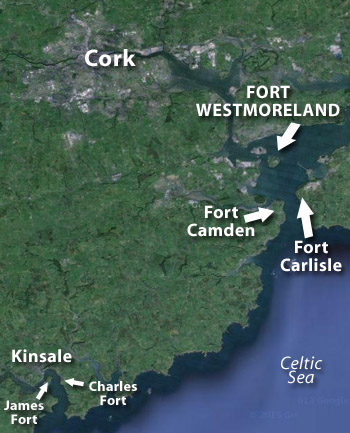 Click on the map to see Click on the map to see
the United Kingdom's official starfort map! |
|
Cork considers its harbor to be the second largest natural harbor by navigable area in the world, after that of Sydney, Australia. As we have learned in our study of fortifications in the shape of stars, nice harbors generally sprout forts. Spike Island's first defensive structure was some sort of fortified tower, built at the beginning of the 16th century and probably used by smugglers.
|
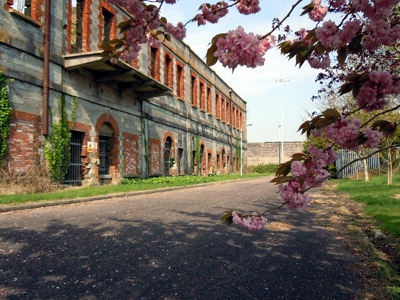 Should I ever perish, I plan to come back as a starfort flower. Should I ever perish, I plan to come back as a starfort flower.
Or maybe a starfort spider. Still considering my options. |
 |
Though historically Great Britain has seldom been the rest of the world's favorite, it was particularly alone in the 1770's. The American colonies revolted in 1775, and France and Spain had joined in the fun on the American side by 1779. Great Britain needed a bigger and better naval base on southern Ireland, to serve as a embarkation point for convoys to the Americas.
Southern Ireland also needed new defenses, as the USS Ranger, an American sloop-of-war commanded by John Paul Jones (1747-1792), was in April of 1778 dashing about the Irish Sea, messing with British merchant shipping. This predictably horrified those of the British hoidy-toidy class, and it was those hoidy-toids who held Great Britain's purse strings.
|
|
Spike Island was at this time owned by a gentleman by the name of Nicholas Fitton, who leased a portion of his island to the British government, and continued to live thereon when the Spike Island Battery was built in 1779. This battery was a temporary edifice, armed with eighteen 24-pounder guns that had been previously utilized at nearby Cove Fort, a square fortlet that had been built along the northern shore of Cork Harbor in 1743. With the end of the American Revolutionary War (1777-1783) came the joyous realization that there would never ever be any sort of armed conflict again, so the Spike Island Battery was dismantled.
|
Responsible for the fortification of Cork Harbor during the War of American Unpleasantness had been Colonel Charles Vallancey (1731-1812). He convinced the authorities that a permanent fort on Spike Island would be the wisest course, with which it's difficult to disagree today, as it resulted in such a perfect starfort specimen.
The Lord Lieutenant of Ireland at this time was John Fane, 10th Earl of Westmorland (1759-1841), Westmorland being a county in northwestern England. I have seen Fort Westmoreland also spelled "Westmorland," which is confusing, but Britain both rules the waves and waives the rules, so they can spell stuff however they want to.
|
 |
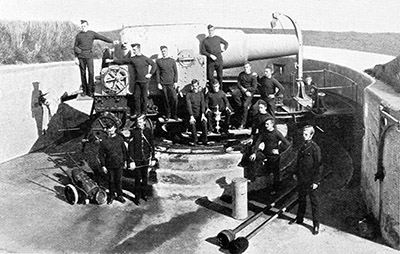 The Royal Garrison Artillery (RGA) and their 12.5-inch Rifled Muzzle Loader (RML), at Fort Westmoreland's No. 3 Bastion (N3B (I made that up)), in 1899. The Royal Garrison Artillery (RGA) and their 12.5-inch Rifled Muzzle Loader (RML), at Fort Westmoreland's No. 3 Bastion (N3B (I made that up)), in 1899. |
|
Work on Fort Westmoreland began in 1790. The home of Nicholas Fitton, who had owned Spike Island when the government first arrived with building materials in the 1770's, was finally demolished to make way for the new fort. The Earl visited Spike Island in 1790 so as to bestow his holy name upon the project. Which is a shame, because while "Fort Westmoreland" is a fine name for a fort, "Spike Fort" would have been way cooler.
The Lord Lieutenancy of Ireland passed to William Fitzwilliam, 4th Earl Fitzwilliam (1748-1833), in 1794. One of Earl William's first acts was, for whatever reason, to halt all work on Fort Westmoreland. Which was at least better than renaming it "Fort Fitzwilliam." Was it because of the fort's relationship to the previous Lord Lieutenant that Fitzwilliam pulled the plug on Fort Westmoreland? Earl William won't respond to my text messages, so I can't say.
|
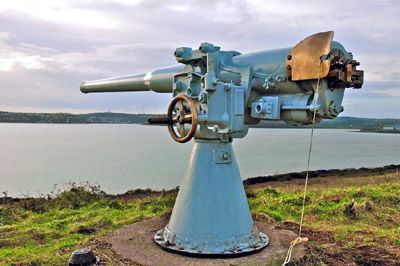 A QF 12-pounder gun at Fort Westmoreland. This gun identification comes to us courtesy of John Mulcahy, who served with the 23rd Infantry Bn (FCA), an Irish Army unit whose responsibilities included some of Cork Harbor's fortifications, in the 1980's. Thanks for your alert attentiveness to the matter of gun identification, John! A QF 12-pounder gun at Fort Westmoreland. This gun identification comes to us courtesy of John Mulcahy, who served with the 23rd Infantry Bn (FCA), an Irish Army unit whose responsibilities included some of Cork Harbor's fortifications, in the 1980's. Thanks for your alert attentiveness to the matter of gun identification, John! |
 |
The first iteration of Fort Westmoreland was completed by 1802. Though impressively armed with 29 24-pounder guns, two 12-pounder guns, twelve 6-pounder guns, a couple of 6-inch field guns, two 5.5-inch howitzers, and thirteen mortars ranging in size from 5.5-inch to 13-inch, this first Fort Westmoreland somehow did not make the British feel that Cork was secure.
The French had come very close to landing 15,000 men at Bantry Bay, on Ireland's southwestern tip, in 1798. This invasion would have been in support of an uprising by the United Irishmen, which took place from May to September of that year. Most of the French fleet arrived as planned at Bantry Bay in December of 1798, but the delay of the French flagship, the Fraternité, freaked everyone out and the French elected to return home sans invasion. |
|
Despite the fact that this had been a wacky un-invasion, the episode had been disquieting, and shortly after the first Fort Westmoreland was completed it was agreed that a "major fortification" would be built on Spike Island. This fortification should be able to garrison up to 3,000 troops, and would look...a lot like the image at the top of this page!
The cornerstone for the final iteration of Fort Westmoreland was laid on June 6, 1804, by General Sir Eyre Coote. Coote, a soldier and politician, would later distinguish himself in 1815 by paying select students of a boy's school to both be flogged by, and then flog him. Which one imagines held some sort of sexual thrill for Coote, who, upon discovery, was subsequently stripped of his rank and dismissed from both the army and Parliament. But none of this has anything to do with Fort Westmoreland. Moving on.
|
The cost for the construction of the final Fort Westmoreland was originally budgeted at £10,000. This was a relatively low price, as the labor would be free: Convicts just love to build stuff for the government that incarcerated them! This lasted until 1867, when the convicts were assumedly all liquidated (not really, they were all transferred to the Royal Navy. So the navy liquidated them), and work on the fort was completed with something called "military labour."
The finished product's main armament consisted of three 12-inch RMLs (Rifled Muzzle Loaders), on the fort's No. 3 Bastion. A number of 7-inch RMLs also bristled from atop Fort Westmoreland's casemated pointy bastions.
|
 |
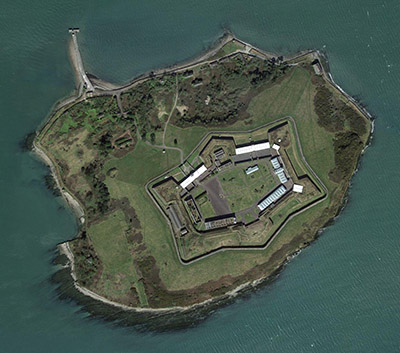 Spike Island, Cork Harbo(u)r. Spike Island, Cork Harbo(u)r. |
|
The starfort of our current interest received a number of armament upgrades over the next 50 years, and was of course utilized by the British as a prison during this period. Mostly holding Irish prisoners prior to deportation to such delightful British penal colonies as Australia, Fort Westmoreland gained a reputation as "Ireland's Alcatraz." |
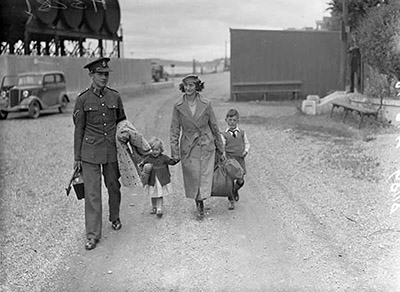 Lance Corporal EJ Thomas of the British Army and his family evacuate Spike Island in 1938. Even little Nigel is wearing a vest and tie: What is with you, England?! Lance Corporal EJ Thomas of the British Army and his family evacuate Spike Island in 1938. Even little Nigel is wearing a vest and tie: What is with you, England?! |
 |
But something completely unexpected occurred in 1922: Ireland was granted independence, sort of. Great Britain retained sovereignty over Cork Harbor as one of three Irish "Treaty Ports" for a time, but it was eventually reasoned that, should Ireland prove to be hostile in any future conflict (and who could blame Ireland were it to be thus), these ports would be virtually impossible for Britain to support.
Spike Island, and the rest of the defenses of Cork Harbor, were officially handed over to Ireland on July 11, 1938. The fort was immediately (and unfortunately) renamed Fort Mitchel, after Irish activist John Mitchel (1815-1875), who spent some time in a casemate-turned-prison-cell at the Fort Previously Known as Westmoreland before being transported to Bermuda around 1850. |
|
During the Second World War (1939-1945), Fort Mitchel's remaining 6-inch BL (Breech Loading) guns were remounted in casemates, and four 40mm Bofors Guns were added to the fort's defenses in an antiaircraft role.
Fort Mitchel remained a military base and prison in the service of Ireland until the beginning of the 21st century. A small community of permanent residents lived on Spike Island during this period, supporting the prison. In September of 1985 the inmates rioted, and for a time held the prison officials, guards and civilians on the island hostage. Assumedly this situation was sorted out at some point, and the prison closed for good in 2004.
Today, Spike Island and what is again generally referred to as Fort Westmoreland (thank goodness) is utilized by an endeavor known as Spike Island Adventure. This is described as a boot-camp style team adventure playground designed for team building. Want to get dirty, wet and cold with your officemates, and pay for the privilege? Here's the place to do it!
|
|
|
|
|
|
 |




